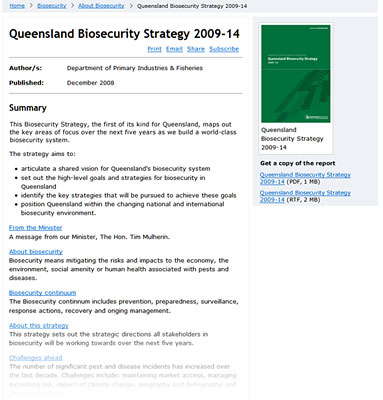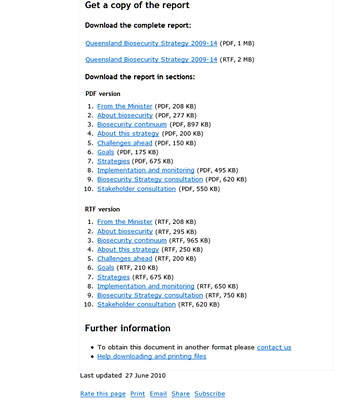Module 6: Checkpoint 3—Document summary pages and sections
| Conformance: Mandatory |
Requirements
Non-HTML documents must use an HTML summary page.
Exceptions to this include instances where:
- an HTML version already exists, providing a summary page entry point
- the document context is provided - in-text linking should be used instead (followed by the file type and size).
Non-HTML documents that exceed maximum file size requirements must be made available in sections. (Refer to Checkpoint 5 - File size requirements for maximum file size requirements.) These sections:
- should be appropriate and logical within the document context, such as chapters
- must comply with all other checkpoints of this module
- must include a complete version of the document for printing.
A complete version of the non-HTML document must also be provided with the following requirements:
- the link to the complete version is placed above the list of document sections
- it is clearly defined as a large file (e.g. over 1 MB) for offline/print purposes
- an accessible current version of the complete document is also supplied.
Benefits of conformance
- Improved usability for all visitors.
- Graceful delivery of two formats of the same document (HTML and non-HTML) in a consistent, user-friendly and accessible manner.
- Improved search engine listing, resource discovery and content promotion.
- Users are provided with a way to assist navigation, find content, and determine where they are.
- Users can read a summary of the document that assists them to identify their required information, before they commence downloading the file.
- Users can choose which document format they will access, rather than forcing all users to access the same format.
- Users can choose to view the most current version of a non-HTML document, or an older version.
- Summary pages increase marketing and promotional options by providing persistent and marketable URLs for non-HTML documents (refer to Module 3: URL persistence).
- Can be easier to maintain for web teams as all links point to the summary page (no searching for all links to a non-HTML document).
Risks of non-conformance
- Users may access non-current information
- User dissatisfaction and website abandonment:
- Users directed to a non-HTML document without warning may experience dissatisfaction and possible confusion if unable determine their location within a website.
- Users may expect non-HTML documents to appear and operate in predictable and consistent ways to HTML (navigational mechanisms are not consistent from HTML to non-HTML).
- Users may reference non-current and inaccurate information if linking directly to a non-HTML document; an HTML summary page would assist the user to locate the most current version.
Implementation advice
Explanation
User research (Queensland Usability 2005 report), indicated that 68% of respondents preferred to have the option to choose to either download a whole document or individual chapters (as required). Further, 30% of respondents had difficulties or were unable to download a non-HTML document.

Example of accessible HTML format with supplementary links to PDF and RTF formats.

Example summary page with the non-HTML document provided as a full document and then divided into sections. Accessible RTF files are made available (in addition to PDF) and contact details are provided.